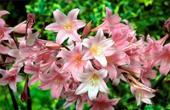Bleeding

Deadly poison! Nightshade - Solanaceae. Folk names: mad cherry, insane berry, sleepy cherry, damn berry, drunken bush. Used parts: leaves, sometimes all grass, root. Pharmacy: belladonna leaves - Belladonnae folium( formerly: Folia Belladonnae), belladonna root - Belladonae radix( formerly: Radix Belladonnae).
Botanical description
Perennial plant with a very long main root, from which every year grow numerous straight, blunt-branched, highly branched shoots, reaching 1.5 m in height. The leaves are located in the upper part of the shoot in pairs( one large and one small) in opposition. Between the leaves on long stalks are sitting single drooping flowers, on the outside are brownish-violet, and inside - dirty yellow with purple-red veins. Ripe fruit - glossy-black juicy berries the size of a cherry. Blooms from June to August. It grows in Europe and Asia Minor at light edges, prefers limestones and soils rich in calcium. Belladonna is a deadly poisonous plant! Lovers should neither collect it, nor apply! In all parts of the plant contain poisons! For children, its brilliant blue-black berries are particularly dangerous, which in no way can be eaten, because only a few berries can be a lethal dose for a child. The fact that thrushes, starlings and other birds eat "mad cherry" does not at all mean that it is not poisonous to humans.
Active substances
Atropine, hyoscyamine, sko-polyamine and other alkaloids close to them.
Healing and application
It should be strongly warned about the inadmissibility of self-using belladonna. Nevertheless, it can be argued that this is an extremely important medicinal plant, which is truly irreplaceable in the hands of doctors, mainly in the form of finished preparations. Preparations krasavki( extracts or tincture) are used to treat gastrointestinal diseases associated with convulsive pain. These medications doctors prescribe also for bronchial asthma and various neuralgia;At treatment of eye illnesses use pure atropine. Use in homeopathy. The homeopathic preparation Belladonna is prepared from a whole fresh plant. The agent is used mainly in dilution degrees D1-D6 with spasms of all cavity organs, with asthma, stomach ulcer and colic. With periodic heart pains, various neuralgia and especially with gout, a belladonna is also prescribed.
Application in folk medicine
Nowadays in folk medicine refuse to use such a dangerous medicinal plant, but previously extracts and extracts of belladonna with wine and juices were taken either inside or as an external remedy for pain of different origins. It is truly amazing that we know almost nothing from ancient sources about the use of the belladonna in medicine, although it is quite obvious that its toxic properties were known. Only the authors of medieval herbalists described this plant in detail. In Tabernemontanus-Baugin we find in the herbalist( Basel, 1731) that the sliced and attached grass of the belladonna heals all ulcers and tumors, the inflamed stomach and liver, while quenching the fever. Although there was also another - infamous - the use of belladonna. From her prepared an ointment, which was used during the trials of witches. When it was rubbed, the active substances got into the blood, which caused hallucinations, and the victims under torture told everything that they demanded of them. From the belladonna also made poisons and love potions.
Side effects
Signs of poisoning by bellies - dry mouth, scratching sore throat with difficulty swallowing, thirst, vomiting, dizziness and headache. Then there are hallucinations with bouts of violent insanity, after which death occurs in 3-15 hours. A very characteristic feature is sharply dilated pupils, which increase very soon after poisoning with bellies. At the first sign of poisoning, immediate first aid should be given.
